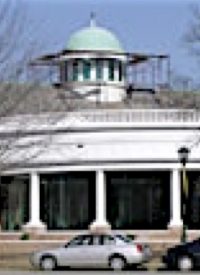
A conservative legal advocacy group has come to the rescue of a New Jersey man who was told by authorities in his community that he could not display a cross in his yard. In early July the Alliance Defense Fund sent a letter to officials in the township of Livingston (picture, left) asking them to cease from employing an ordinance prohibiting homeowner Patrick Racaniello from displaying crosses in various areas of his front yard. Local police had used the ordinance as justification for ordering Racaniello to remove a cross he was displaying on a tree in his front yard in celebration of Lent, after one of his neighbors had complained.
“It’s ridiculous to stop citizens from displaying a cross on their own property,” said ADF attorney Jonathan Scruggs, who is representing Racaniello. “The Constitution guarantees the right of Americans to express their religious beliefs in this fashion, and no local ordinance can trump that.” Scruggs noted that in the present case, “the ordinance itself doesn’t actually even prohibit these crosses. The law is being used in a vague fashion to stop him from doing what he wishes on his own private property.”
It all started last April when Racaniello placed a 31-by-19-inch wooden cross on a tree in his front yard to celebrate the Lenten season. But when one of his neighbors “screamed objections about the cross at him and his family,” reported the ADF in a press release, “Racaniello called the police, who later ordered him to remove the cross, citing an ordinance that said his display was against the law because it was located within eight feet of the street curb.”
Concerned that he might get a ticket from the police, Racaniello complied with the ordinance, moving the cross so that it was a safe and legal nine feet from the curb, where he again displayed it in his yard. But by this time, township officials had apparently decided to make Racaniello’s Christian display a more personal issue, telling him he was in violation of Livingston Ordinance 178-11 requiring that the township have a 10-foot unencumbered right-of-way into his yard. A zoning inspector sent Racaniello a letter demanding him to “move the cross to another location on your property, outside of the Township right-of-way and not on any tree….”
Not wishing to face the wrath of the community’s zoning board, who had gone so far as to prohibit him from displaying a cross on any tree on his property, Racaniello removed the display of his Christian faith and contacted the Alliance Defense Fund for help in the case.
In a letter to the city officials, the ADF’s Scruggs cited several First Amendment cases in which various courts, including the U.S. Supreme Court, had ruled against communities attempting to enforce ordinances similar to the ones Livingston Township was using against Racaniello. “It is well-settled that the cross communicates a clear Christian message and constitutes protected speech,” wrote Scruggs, referencing such cases as Capital Square Review and Advisory Board v. Pinette (1995), Congregation Lubavitch v. City of Cincinnati (1993), and Draper v. Logan County Public Library (2005). “Thus, Mr. Racaniello’s desired expression is clearly covered by the First Amendment.”
Using a myriad of First Amendment cases to demonstrate that Livingston Township was violating the Constitution in its prohibition against his client, Scruggs concluded the letter by demanding the officials assure ADF that “you will allow Mr. Racaniello to display his cross” wherever he wishes on his property. He gave the township officials three weeks to respond with a letter of compliance or face legal action by the ADF “to protect Mr. Racaniello’s First Amendment rights.”
Photo: A scene in Livingston Township, N.J.



